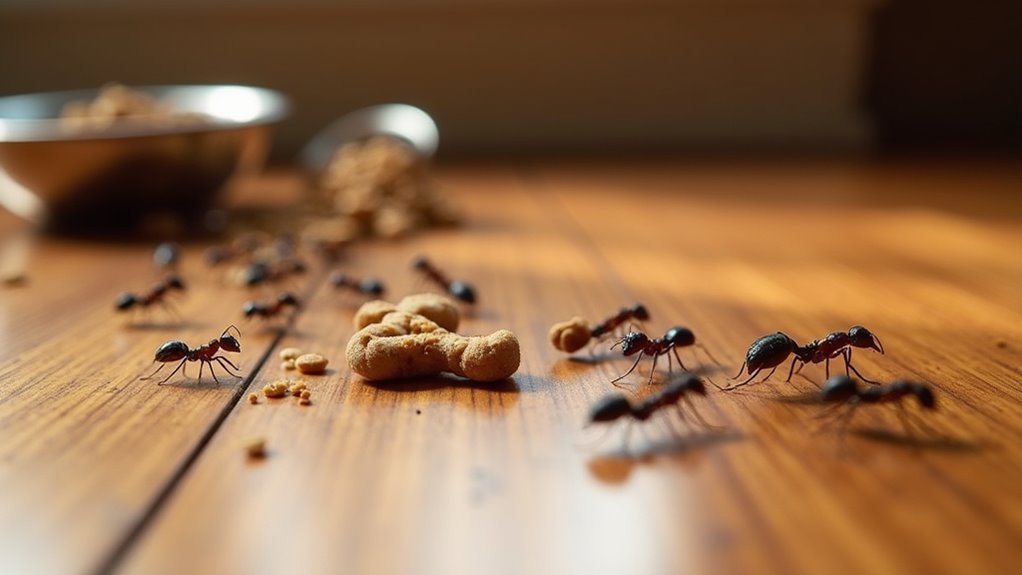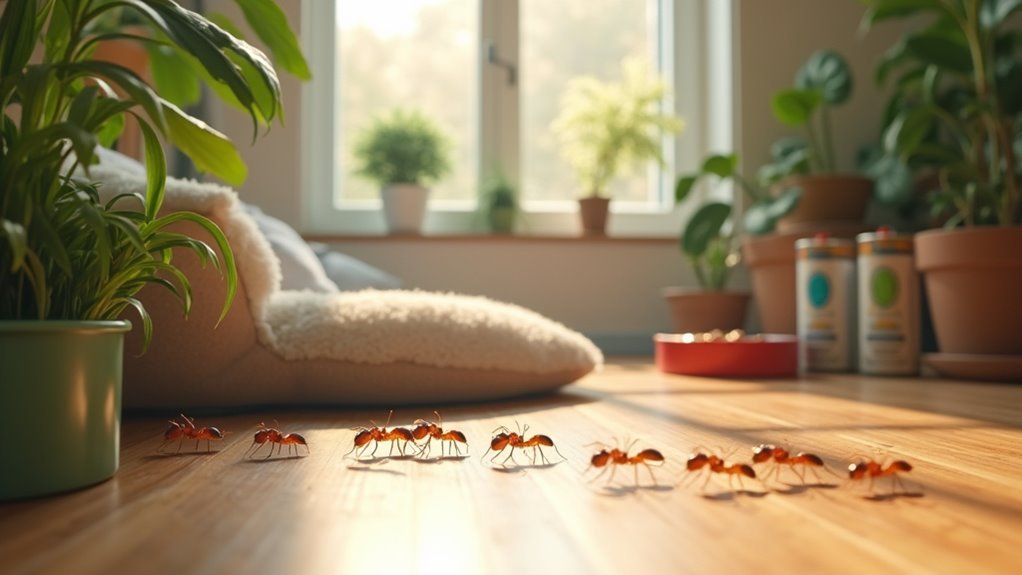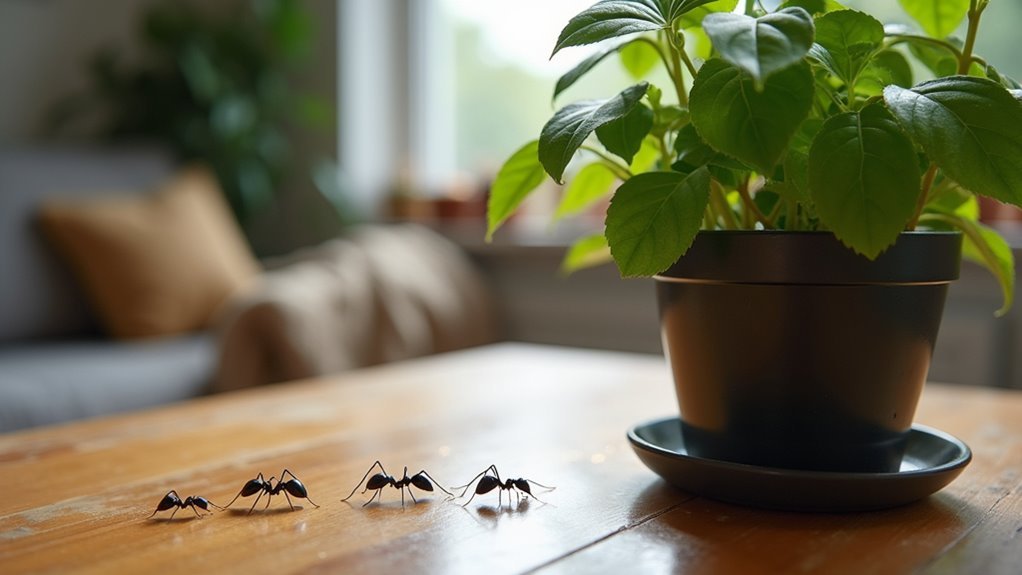Ants invade your pet-friendly home because you’re unknowingly providing everything they need to thrive. Unsealed pet food releases enticing scents, while scattered crumbs and dirty food bowls create abundant feeding opportunities. Water spills and pet accidents leave sticky trails that attract scout ants, who then recruit entire colonies. Your pet’s feeding areas become highways for these unwanted guests, especially when bowls are placed near entry points where ants can easily access them and establish permanent invasion routes.
Common Food Sources That Attract Ants to Pet Homes

Your pet’s dinner bowl might as well be a neon sign advertising “Free Food” to nearby ant colonies. Unsealed pet food releases enticing scents that draw ants directly into your home, making airtight storage containers essential.
Those scattered crumbs from treats and meals create abundant food sources on your floors, requiring consistent cleaning to prevent infestations.
Pet food crumbs scattered across floors become an all-you-can-eat buffet for hungry ant scouts seeking easy targets.
Dirty pet dishes with lingering food residue offer easy meals for foraging ants. You’ll need to wash or rinse bowls immediately after feeding time.
Don’t forget about food and water spills that create sticky trails leading straight to your kitchen.
Pet accidents pose another threat—urine and feces odors attract ants when not cleaned promptly.
Without proper cleaning routines, you’re inadvertently creating the perfect conditions for a serious ant problem.
How Pet Food and Water Bowls Create Ant Problems
Your pet’s food and water bowls create a perfect storm for ant invasions in three critical ways.
When food spills around feeding areas, it sends out chemical signals that attract ant scouts who’ll mark the trail for their entire colony to follow.
You’re also providing ants with essential water sources they need to survive, while poor bowl placement near entry points gives them easy access to both food and hydration in one convenient location.
Spilled Food Attracts Scouts
Pet food bowls create an irresistible buffet for ant scouts searching for their next meal. When you leave spilled food around your pet’s feeding area, you’re fundamentally rolling out a welcome mat for these persistent pests.
Scout ants detect the enticing scent of pet food from considerable distances and quickly relay this information back to their colonies.
Even small crumbs that seem insignificant to you represent a feast for ants. These scouts don’t just target dry kibble – they’re equally attracted to wet food remnants and standing water from bowls.
Once scouts establish your pet’s feeding station as a reliable food source, they’ll mark scent trails for other colony members to follow. This process rapidly escalates minor spills into full-scale ant infestations throughout your home.
Water Sources Draw Colonies
While food crumbs grab initial attention, water sources actually drive ant colonies to establish permanent footholds in your home. Your pet’s water bowl becomes a beacon for thirsty ants, especially during dry seasons when moisture is scarce.
Standing water that isn’t refreshed daily creates the perfect breeding ground for ant infestations.
These tiny invaders don’t just drink and leave—they follow scent trails back to recruit entire colonies. Even minor spills around pet food stations can trigger major invasions, as ants detect moisture from surprising distances.
You can prevent this by keeping your kitchen and pet areas consistently dry. Empty water bowls overnight when possible, wipe up spills immediately, and consider pet-safe ant deterrents around feeding zones to break the moisture cycle attracting these persistent visitors.
Bowl Placement Enables Access
Beyond the moisture factor, strategic bowl placement becomes your most powerful defense against ant invasions. Your pet’s feeding station creates a perfect storm when positioned incorrectly. Ants detect pet food from remarkable distances using their superior sense of smell, making exposed bowls irresistible targets.
Food remnants scattered around bowls establish consistent trails that encourage rapid infestations. Once ants discover these reliable sources, they’ll quickly create highways leading directly to your pet’s meals. Every crumb and spill reinforces their presence in your home.
Effective ant control methods focus on disrupting access routes. Place bowls in water-filled trays or elevate them on smooth surfaces. Store pet food in sealed containers and clean surrounding areas immediately after feeding.
These simple bowl placement strategies create barriers that maintain your pest-free home.
Natural Pet-Safe Methods to Eliminate Ant Trails
You can eliminate ant trails naturally without endangering your pets by using essential oils that disrupt their scent pathways.
Vinegar solutions offer another effective approach, masking the chemical trails ants follow to navigate your home.
Food-grade diatomaceous earth provides a third option, creating barriers that eliminate ants on contact while remaining completely safe for your furry companions.
Essential Oil Disruption Methods
Essential oils offer a powerful, pet-safe solution for disrupting ant communication networks and eliminating their persistent trails. These natural ant repellent options work by masking scent markers that ants use for navigation while providing an effective solution that won’t harm your pets.
| Essential Oil | Minimum Effective Concentration |
|---|---|
| Peppermint | 5% |
| Tea Tree | 5% |
| Citrus | 5% |
| Eucalyptus | 5% |
You can create your own ant control spray by mixing equal parts water and essential oil in a spray bottle. Apply this mixture around entry points and existing trails to repel ants effectively. The oils provide dual-action benefits—they disrupt communication while killing ants on direct contact, making them an ideal choice for pet-friendly homes.
Vinegar Trail Masking Solutions
While essential oils provide excellent ant control, vinegar offers an equally effective and budget-friendly alternative that’s completely safe for your pets.
This powerful home remedies solution disrupts ant trails by masking scent markers that guide colonies to food sources. Mix equal parts white vinegar and water, then spray directly onto existing ant trails and entry points where you’ve noticed ant activity.
The strong acidic smell interferes with ants’ communication system, preventing them from maneuvering effectively through your home.
This pet-friendly repellent becomes safe for your furry companions once it dries completely. Regular application creates a protective barrier that deters future infestations.
Unlike harsh chemical treatments, vinegar won’t harm your pets while effectively eliminating the invisible highways ants use to invade your space.
Diatomaceous Earth Application Techniques
Food-grade diatomaceous earth stands out as one of nature’s most effective ant eliminators that won’t endanger your beloved pets.
This pet-friendly powder works by damaging ant exoskeletons, causing fatal dehydration without toxic chemicals.
For ideal ant control, lightly sprinkle diatomaceous earth along ant trails and entry points where you’ve spotted activity.
Keep applications dry since moisture destroys its effectiveness. You’ll need to reapply after cleaning or rain to maintain its power.
Focus your application techniques on outdoor problem areas like gardens and pet feeding stations, keeping ants away before they enter your home.
Remember that food-grade DE works best when combined with good hygiene practices.
Clean spills promptly and seal food containers to make your space less attractive to invading ants.
Essential Oils and Household Items for Ant Control
When ants invade your home, you don’t need harsh chemicals to send them packing—your kitchen cabinets and medicine cabinet likely contain everything you need for effective ant control.
Essential oils like peppermint, tea tree, and citrus work as powerful deterrents by disrupting ant scent trails, making navigation impossible. These natural substances are completely safe for pets while remaining highly effective to eliminate unwanted pests.
Common household items also provide excellent solutions.
Mix equal parts vinegar and water to create a spray that masks scent trails around entry points. Sprinkle food-grade diatomaceous earth along ant pathways—it’ll dehydrate them on contact.
Create bait using baking soda mixed with sugar, or scatter coffee grounds and lemon juice around problem areas for chemical-free protection.
Protecting Pet Areas From Outdoor Ant Invasions

Your pet’s outdoor feeding area represents one of the most vulnerable spots for ant invasions, as spilled kibble and water bowls create irresistible attractions that can quickly lead these persistent insects straight into your home.
Spilled pet food and water dishes transform outdoor feeding stations into ant highways leading directly to your front door.
You’ll need pet-friendly solutions for keeping ants away from these critical zones. Store food in airtight containers and clean spills immediately. Create physical barriers by placing bowls in water-filled trays or applying petroleum jelly around bases.
Sprinkle ground cinnamon or citrus peels around areas where ants typically gather—these natural repellents won’t harm your pets. Regular inspection prevents infestations by catching ant trails early.
Address plumbing leaks promptly, as moisture attracts scouts seeking water sources for effective ant removal.
When to Seek Professional Help for Persistent Ant Issues
Despite implementing all the recommended pet-safe prevention methods and maintaining vigilant cleaning schedules, some ant invasions prove too stubborn for DIY solutions.
When persistent infestations continue despite your best efforts, it’s time to contact a professional pest control service.
Consider professional intervention when:
- Ant activity increases despite consistent cleaning and pet-safe treatments
- Over-the-counter ant control products fail to eliminate the problem after multiple applications
- You’ve identified aggressive species like fire ants that pose health risks to your pets
- Hidden nests remain undetected, allowing colonies to rebuild repeatedly
- You’re uncertain about product safety and need expert guidance on pet-friendly options
Professionals provide targeted treatments that effectively eliminate colonies while ensuring your pets’ safety, preventing costly home damage and protecting your family’s health.
Frequently Asked Questions
How Do You Get Rid of Ants in Your Pet Safe?
You can use food-grade diatomaceous earth, vinegar solutions, or peppermint essential oil to eliminate ants safely. Clean spills promptly, store pet food in airtight containers, and place EPA-approved bait stations away from pets.
What Does It Mean When Ants Are Around Your House?
When ants are around your house, it means they’ve found food sources, water, or shelter. You’re dealing with scout ants leaving scent trails that’ll attract more colony members to infest your home.
Why Am I Getting Ants in My Clean House?
You’re getting ants because they detect food odors from fifty feet away. Hidden crumbs, unsealed containers, dirty dishes, plumbing leaks, and pet food residue create attractants despite your home appearing clean.
Why Do I Suddenly Have an Ant Infestation?
You’re suddenly experiencing ant infestations because ants detected food sources like pet food or crumbs, followed scent trails indoors, and found moisture from leaks, especially during warmer weather when they’re most active.
In Summary
You’ve learned that your pet’s food, water bowls, and outdoor access points create perfect ant highways into your home. By removing food sources, cleaning spill areas immediately, and using pet-safe deterrents like cinnamon or vinegar, you’ll protect your furry friends while keeping ants away. Remember, consistency is key—maintain these practices daily. If ant problems persist despite your efforts, don’t hesitate to contact professional pest control for pet-safe solutions.





Leave a Reply